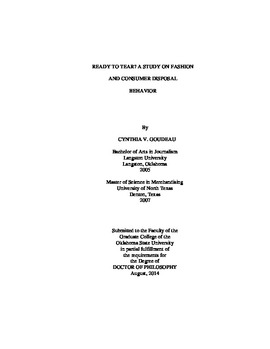| dc.contributor.advisor | Lee, Hyun-Joo | |
| dc.contributor.author | Goudeau, Cynthia V. | |
| dc.date.accessioned | 2015-06-17T20:06:02Z | |
| dc.date.available | 2015-06-17T20:06:02Z | |
| dc.date.issued | 2014-08 | |
| dc.identifier.uri | https://hdl.handle.net/11244/14854 | |
| dc.description.abstract | In the apparel and textiles industries, disposal is of great interest because the amount of textile waste produced annually is on the rise. This study was concerned with gaining comprehensive insight into apparel disposal behaviors, so the purpose of the research was two-fold. First, the research aimed to evaluate the antecedents to apparel disposal behaviors of young U.S. consumers using an extended version of the Theory of Reasoned Action. Second, the research intended to compare the young consumers' actual disposal behaviors in relation to fast fashion and non-fast fashion apparel. Four structural equation models were built to explore antecedents (i.e. environmental apparel knowledge, apparel disposal motivation, apparel disposal attitude, apparel disposal subjective norm, and apparel disposal intention) to the most commonly cited apparel disposal behaviors: resell, donate, reuse, and discard. Paired t-tests and cross-tabulations with chi-square statistics were utilized to investigate the differences in disposal rates, disposal methods, and reasons for disposal used by consumers for fast fashion and non-fast fashion apparel. Results for the conceptual framework varied from model to model. The resell model showed no significant relationship between environmental apparel knowledge and apparel disposal motivation. Additionally, no significant relationship was shown between apparel disposal attitude and apparel disposal intention in the resell model. All relationships between antecedents were found to be significant in the donate model. With the exception of the connection between apparel disposal subjective norm and apparel disposal intention, all antecedent relationships were found to be significant in the reuse and discard models. In the comparison of disposal behaviors, it was found that participants disposed of fast fashion apparel overall at a faster rate than non-fast fashion apparel. The average disposal rate for fast fashion apparel was significantly faster than the average rate for non-fast fashion apparel in both the resell and donate categories, but no difference was noted in the reuse and discard categories. Implications and future research suggestions are offered at the study's conclusion. | |
| dc.format | application/pdf | |
| dc.language | en_US | |
| dc.rights | Copyright is held by the author who has granted the Oklahoma State University Library the non-exclusive right to share this material in its institutional repository. Contact Digital Library Services at lib-dls@okstate.edu or 405-744-9161 for the permission policy on the use, reproduction or distribution of this material. | |
| dc.title | Ready to tear? A study on fashion and consumer disposal behavior | |
| dc.contributor.committeeMember | Swinney, Jane Lowry | |
| dc.contributor.committeeMember | Peek, Gina | |
| dc.contributor.committeeMember | Kang, Mihyun | |
| dc.contributor.committeeMember | Gates, Gail | |
| osu.filename | Goudeau_okstate_0664D_13487.pdf | |
| osu.accesstype | Open Access | |
| dc.type.genre | Dissertation | |
| dc.type.material | Text | |
| thesis.degree.discipline | Design, Housing and Merchandising | |
| thesis.degree.grantor | Oklahoma State University | |
